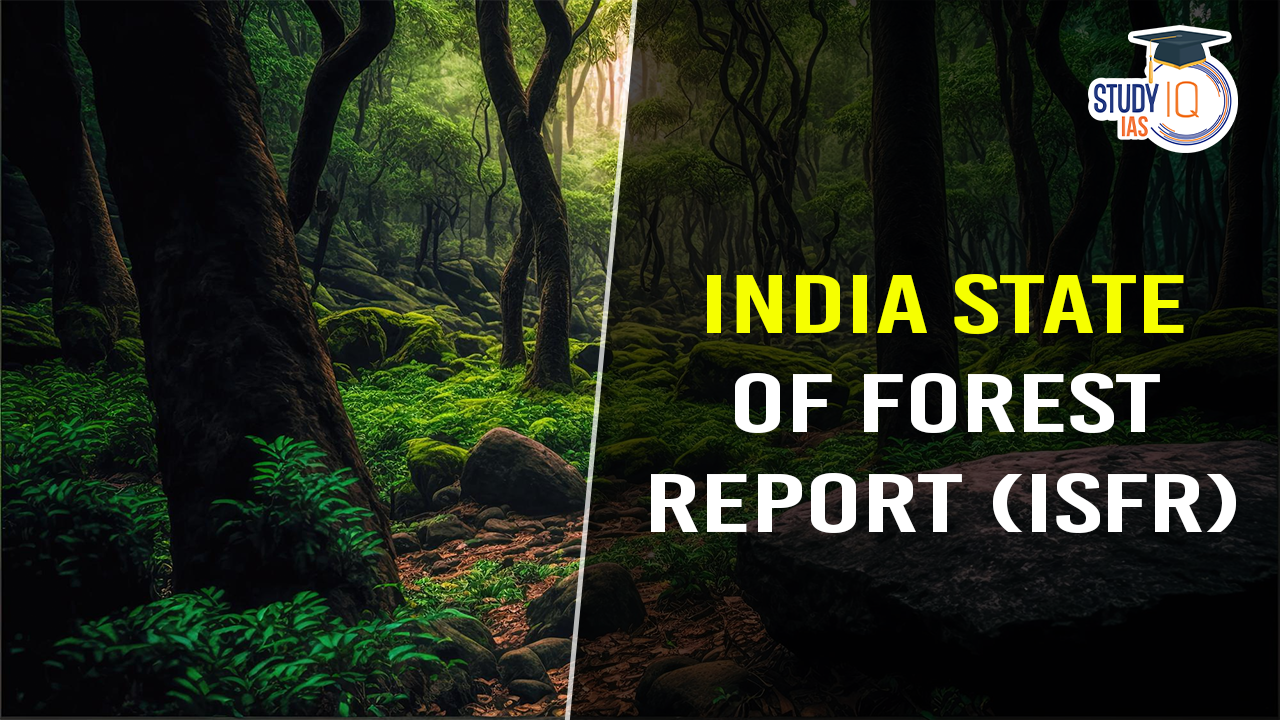Table of Contents
Context: Recently, the Minister for Environment, Forest and Climate Change released the ‘India State of Forest Report 2023.
Key stats of India State of Forest Report 2023 (ISFR 2023)
- Total Forest and Tree cover of the country – 8,27,357 sq km. It is 17% of the geographical area of the country.
- Out of 17% – 21.76% is forest cover and 3.41% is tree cover.
- Top 3 states having largest forest and tree cover (Area Wise): Madhya Pradesh, Arunachal Pradesh and Maharashtra.
- Top 3 states having the largest forest cover (area-wise): Madhya Pradesh, Arunachal Pradesh and
- Top 3 States having largest forest cover (% wise): Lakshadweep (91.33%), Mizoram (85.34%) & Andaman & Nicobar Island (81.62 %).
- The present assessment has revealed that 19 states/UTs have above 33 per cent of the geographical area under forest cover.
- Out of these, 8 states/UTs: Mizoram, Lakshadweep, A & N Island, Arunachal Pradesh, Nagaland, Meghalaya, Tripura, and Manipur have forest cover above 75%.
- The total mangrove cover in the country: is 4,992 sq km.
- Total extent of Bamboo bearing area: 1,54,670sq km.
- As compared to the last assessment there is an increase of 5,227 sq km in bamboo area.
- Total Carbon Stock in India’s forest: 7,285.5 million tonnes.
- There is an increase of 81.5 million tonnes in the carbon stock of the country as compared to the last assessment.
- Changes Compared to 2021 assessment: Increase in Total Forest and Tree Cover: +1,445 sq km.
- States with Maximum Increase Forest and Tree Cover Increase (Top 4 States): Chhattisgarh, UP, Odisha & Rajasthan.
- Top 3 states showing maximum increase in forest cover: Mizoram, Gujarat & Odisha.
| India State of Forest Report |
|
| UPSC PYQ |
Q. Consider the following States: (2019)
With reference to the State mentioned above, in terms of percentage of forest cover to the total area of State, which one of the following is the correct ascending order? (a) 2-3-1-4 (b) 2-3-4-1 (c) 3-2-4-1 (d) 3-2-1-4 Answer: C |
Comparison Between The Forest Survey Of India And The Satellite Imagery Analysis
| Aspect | Forest Survey of India (FSI) | Satellite Imagery Analysis (University of Copenhagen) |
| Data Sources | Sentinel satellite | RapidEye and PlanetScope satellites |
| Analysis Method |
|
|
| Focus |
|
|
| Survey Frequency | Regular surveys (biennial) | Analysis conducted for 2010-2022 |
| Specific Findings | Increase in tree cover of 2261 sq km. between 2019-2021. |
|
About Forest Survey of India (FSI)
The Forest Survey of India (FSI) is a premier national organisation under the Union Ministry of Environment Forest and Climate Change, responsible for the regular assessment and monitoring of the country’s forest resources. FSI also provides training, research, and extension services.
Establishment of Forest Survey of India (FSI)
FSI was established on June 1, 1981, succeeding the “Pre-investment Survey of Forest Resources” (PISFR), a project initiated in 1965 by the Government of India with sponsorship from FAO and UNDP.
Background
- The main objective of PISFR was to ascertain the availability of raw materials for the establishment of wood-based industries in selected areas of the country.
- In its 1976 report, the National Commission on Agriculture (NCA) recommended the creation of a National Forest Survey Organization for regular, periodic, and comprehensive forest resources surveys, leading to the establishment of FSI.
- After a critical review of activities undertaken by FSI, the Government of India redefined the mandate of FSI in 1986 to make it more relevant to the rapidly changing needs and aspirations of the country.


 Sea Weeds: Nutritional Powerhouse From T...
Sea Weeds: Nutritional Powerhouse From T...
 6th BIMSTEC Summit 2025: Key Highlights,...
6th BIMSTEC Summit 2025: Key Highlights,...
 Excess Fluoride in Sonbhadra’s Groundw...
Excess Fluoride in Sonbhadra’s Groundw...





















